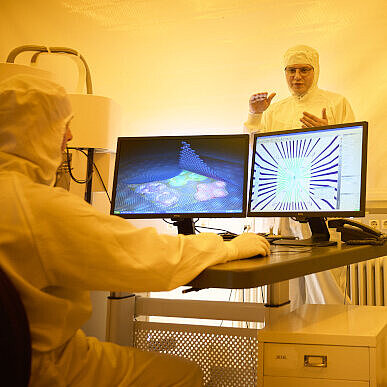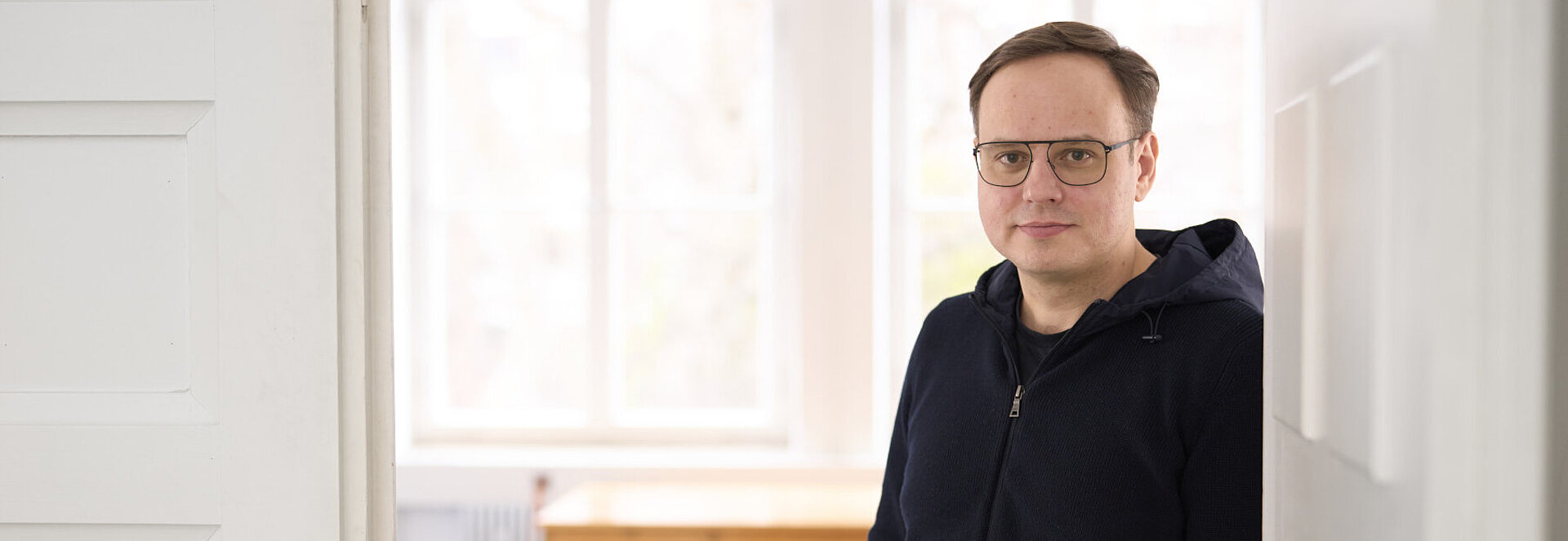Quantum Physics and Graphene
A material that exists only in the second dimension? For Professor Dmitri Efetov, what might sound like science fiction is simply routine research: "Graphene is a material that is no more than an atom thick," the solid state physicist explains. "It’s as thin as you get: existent on a plane, but virtually non-existent in terms of height—an extremely flat nanomaterial." Nor is this the only futuristic property of graphene, a modification of the chemical element carbon: In a layer of graphene, the electrons become massless. And if you put two layers of it in relation to each other at a 'magic' angle, the result is a plethora of exotic 'quantum phases'. The graphene becomes superconductive, magnetic and topological, for example. "Graphene really does possess all the qualities that are currently of interest to modern solid state physics," Efetov says.
Nobel Prize for the Discovery of Graphene
The German-Russian scientist took the Chair of Experimental Solid State Physics at LMU in August 2021, and graphene research has been a constant theme throughout his career. Born in Moscow, Efetov grew up in Stuttgart and Bochum, studied physics at establishments such as the ETH in Zurich, and was already conducting research into graphene while studying for his doctorate at Columbia University, New York. Back then, this remarkable and astonishingly simple-to-make material had only just been investigated closely for the first time, leading to a Nobel prize for scientists in England.


Superconductivity in Quantum Computing
"'Relativistic electrons' are one of many features that make graphene special," says Efetov. "They don’t behave like normal electrons, but more like light particles in that they are massless." In the course of his doctoral research, he too attempted to make graphene superconductive. Back then, achieving such a state appeared virtually impossible. "Superconductivity is a material state in which electric current can flow with no loss of energy," he explains. "Since conventional conductors give off heat—i.e., energy—a great deal of energy gets lost in traditional power lines, most of which could be avoided by using superconductors." Efetov adds that superconductors are central elements in modern quantum technologies such as quantum computers, which consist of complex superconductive networks: "One major objective of graphene research is to develop new kinds of superconductive states that exhibit completely new properties." During his doctoral research, however, the scientist managed this feat only after bringing graphene into contact with an existing and familiar superconductor, whose properties were carried over to the new material.
The Magic Angle
As a postdoctoral researcher at the Massachusetts Institute of Technology (MIT), Efetov applied himself as of 2014 to developing quantum detectors that prove the existence of individual light particles. After moving to the Institut de Ciències Fotòniques (ICFO) in Barcelona in 2017, he then led a group conducting research into these detectors. At this time, researchers succeeded in making graphene itself superconductive: Efetov’s team became the third group in the world to reproduce this effect. "The method used to finally make graphene intrinsically superconductive is as ground-breaking as it is unique," he says. "It works if you take two layers of graphene and set them at an angle of 1.1 degrees to each other. That’s what we call the magic angle: Superconductivity is lost at even a 1.0 or 1.2-degree angle."
The discovery of the 'magic angel' is a kind of milestone. The opportunities it opens up in physics are utterly new and decidedly exotic.Prof. Dr. Dmitri Efetov, Head of the Chair of Solid State Physics
Exotic Physics
The researcher is aware that this state is not yet fully understood. "But we are assuming that it is similar to high-temperature superconductivity." Many practical aspects remain to be resolved along the path to superconductivity that can be applied at room temperature, he admits. "But this discovery is a kind of milestone. The opportunities it opens up in physics are utterly new and decidedly exotic." His team has since made further discoveries relating to graphene and today ranks as "one of the key research groups in this field," as he puts it.
Extremely Strong Research Environment
So, now Efetov is pursuing his research in Munich. "LMU has always been on my radar," he says, pointing out that initiatives such as the Munich Quantum Valley and the Munich Center for Quantum Science and Technology adopt a highly interdisciplinary approach. "Solid state physicists like me interact here with researchers in the fields of quantum information, laser physics, and quantum optics."


Supplying Components for Quantum Technology
Within the broad-based discipline of 'quantum technologies,' Efetov tends to focus on pure research. "I myself don’t build quantum computers, even though I could contribute components to this end. I’m rather like a supplier to automotive manufacturers." There is another thing that Efetov appreciates about Munich: "The students here are really very good. That is a tremendous asset for a professor because it lets you recruit good people."
Graphene: Topological, Magnetic, Exotic
He continues to concentrate his research on the potential properties of graphene as a superconductor. "Graphene happens to be 'topological' as well, with currents flowing at its edges, not in the middle. It is also magnetic and, by no means least, what is known as a 'correlated isolator.' That is a reference to a very exotic many-particle state that is also the object of intensive research at present," Efetov explains. Even at LMU’s Chair of Experimental Solid State Physics, it looks like the angled, two-dimensional, magic material will keep him busy for a long time to come.



